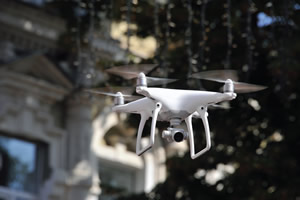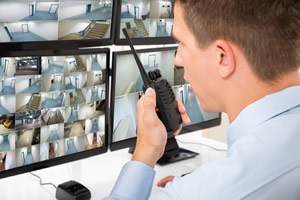Security Technology Wish List

PHOTO © KOROTOVA LIUDMYLA
School security is big
business. Forbes magazine found
in 2015 that two-thirds of colleges
and universities reported that budgets for
campus safety and security have increased
over the past three years. So what are they
buying? Three security professionals share
their latest upgrades, their tried-and-true
technologies and what’s on their wish list.
Western Technical College
La Crosse, WI
Raj Ramnarace, Security and Emergency
Operations manager
As a member of the National Institute
of Justice Technology Working Group,
Ramnarace found two significant challenges
when looking at emerging technologies
for school safety: the cost and the need
to maintain open and free-flowing access
to common spaces. “In the world of higher
education security, anything we add to
our mix must be effective, affordable and
unobtrusive to our educational environment,”
he notes.
Still, there are many leading-edge
technologies he finds both promising and
exciting, including smart sensing devices, video analytics and unmanned aerial systems
— a.k.a. drones. “Each of these can
reliably reduce the task load for security
staff by providing continuous monitoring
of many spaces, independent of human
intervention,” he explains.
Ramnarace is intrigued with smart
sensing devices, because “they can be
designed to detect a variety of threats: intruders,
explosives, gunshots and dangerous
chemicals that create concern in our
post-9/11 world,” he says. These devices
also notify responders. Expect to see these
technologies become as ubiquitous as
video cameras as their cost, size and power
requirements shrink.
As video analytics also continue to
evolve, Ramnarace predicts that smarter
machines will eclipse conventional,
manned video surveillance systems. “This
is inevitable because, with many campuses
using dozens or hundreds of cameras, it
is not cost effective to have sufficient staff
to effectively monitor those cameras on a
round-the-clock basis,” he notes. He also
points to smart video’s abilities to see,
detect and respond to anything and everything
of interest on a video feed, something
no human could possibly do.

PHOTO © ANDREY_POPOV
AUGMENTED REALITY. Video analytics tools incorporate technology that can continuously monitor multiple video feeds
for movement or other details that could escape the attention of a human observer. Video analytics software that zeros
in on an object or event of interest is part of a broader architecture that includes cameras, encoders, servers, storage and
networks. The analytics capability might reside on servers, the cameras or the encoders, which convert video from analog
cameras so the moving images can travel over IP networks. Delivery of video feeds can be made not only to stationary
monitors, but also to mobile devices such as tablets or smartphones. At some point in the supply of data, however, interpretation
of and reaction to flagged content must be instigated by trained personnel who can make decisions on handling
emergent situations.
“Improvements in video resolution
and processing power will make facial
recognition a useful tool that will enable
us to spot people we are looking for on
our campuses,” he says. “Typically, these
include stalkers and people who have
been banned from campus for violent or
threatening behavior.” Video analytics
can also be useful in detecting unusual
items and systems could alert security to
someone who hasn’t moved or appears
to have fallen, as is often case with slips,
trips and falls on campuses.
Ramnarace is also excited about the
evolution of drones. “Assuming regulatory
guidance continues to evolve, we will
someday be able to monitor our exterior
spaces and buildings from a perspective
that previously would not have been
possible,” he says. He points to today’s
consumer drones that are affordable, carry
high-resolution streaming video cameras
and feature programmable flight paths, as
well as auto-collision avoidance and auto-landing
capabilities. “Someday, a drone
patrol force will augment our foot patrol
presence,” he predicts.
While he plans for the future, is there
any technology he wouldn’t dare give up?
“Absolutely!” he says. “Our video surveillance
systems and access control systems
are both crucial to our security operations.
They are dependable and are always getting
better.” He calls the video system a
reliable deterrence and a good way to gain
critical information when investigating
incidents.
Ramnarace states that his school relies
heavily on their networked electronic locking
systems. “Our system enables us to lock
down the dozen buildings that comprise
our main campus in a matter of seconds. To
do the same thing with manual, hard-key
equipment would take significantly longer.
We can remove access to lost, misplaced or
stolen cards or fobs quickly, without having
to rekey vulnerable access points. Additionally,
we can review log data to assess building
usage and security patrol coverage.”
University of North Dakota (UND)
Grand Forks
Mike Lefever, associate director for Emergency Management
Lefever has a top-priority wish list item: an enterpriseintegrated
security system. “This platform offers a complete
security management solution including access control, alarm
monitoring, digital video, CCTV, video badging and visitor management
functionality,” he says via email. “It would enable us to
manage our enterprise-wide security systems from a single point,
while maintaining local operational autonomy.”
While waiting for that, Lefever discusses what he considers
two leading-edge technologies currently in operation: a virtual
emergency management system accessible from a computer or
smartphone and an advanced functionality mobile safety app.
In place for over three years, the virtual emergency management
system creates virtual rooms that can be accessed during an incident.
The rooms include: Daily Briefings, Special Events, Training,
monthly In-Charge of Campus sheets and a Campus Resources Map.
The Campus Resources Map identifies the location of campus
buildings and location of hazardous materials, along with safety
personnel and action plans. The system can also serve as a virtual
Incident Command System during an emergency.
There is also a Daily Briefings room that includes operation
center and university police logs along with news, weather, campus
events and health alerts. Before implementing this system, police
and operation center logs were internal and not regularly shared.
“The most common weakness in any type of emergency situation,
especially those involving community stakeholders and multiple
agencies, is most often a breakdown in communication,” says
Eric S. Plummer, UND’s associate vice president for Public Safety/chief of Police. “This system, along with training for participants,
has greatly reduced the risk of any barriers in communication.”
An essential tool to enhance safety on campus, the Emergency
Management Mobile Safety App sends users important safety
alerts and provides instant access to campus safety resources. The
app can push out instant notifications and instructions during
an emergency or go into Mobile Bluelight mode and open instant
verbal communications between a user and emergency management
staff. The app can also send your location to a friend so he or
she can track your movement in real time.
The app includes interactive campus maps, allows users to
anonymously report safety hazards and stores other safety resources
and emergency plans. It can even help a user get assistance
unlocking car doors or jump-starting dead batteries.
College of Saint Mary
Omaha, NE
David Ferber, MS, director of Safety and Security
Upgrading the College of Saint Mary’s camera system to IP
cameras with NVR is on the to-do list for David Ferber. Network
video recording (NVR) devices use the local network to send and
receive data, and are ideal for remotely monitoring a surveillance
system from a computer, smartphone or tablet. “They hold
more data and because information is stored on the cloud it can
stay there indefinitely,” he says. “Storing information on the
cloud means we can access it even if the power goes out.” Ferber
acquired one camera to test on a new residence hall and liked it
so much he bought one to monitor the bookstore. He’s presently
applying for grants so he can buy more.
He also just switched their emergency text service to an
easier-to-use system. “This one does anything at once. It sends
text alerts, voice message, email and social media posts instantly,”
he says. Ferber also likes that this system comes with a
desktop interrupted system. This allows messages to interrupt a
lecture by displaying across projection screens and computers.
“Assuming the students have their phones put away during class,
this gives us an extra level of safety. It’s exciting to finally be able
to do that.”
This article originally appeared in the issue of .